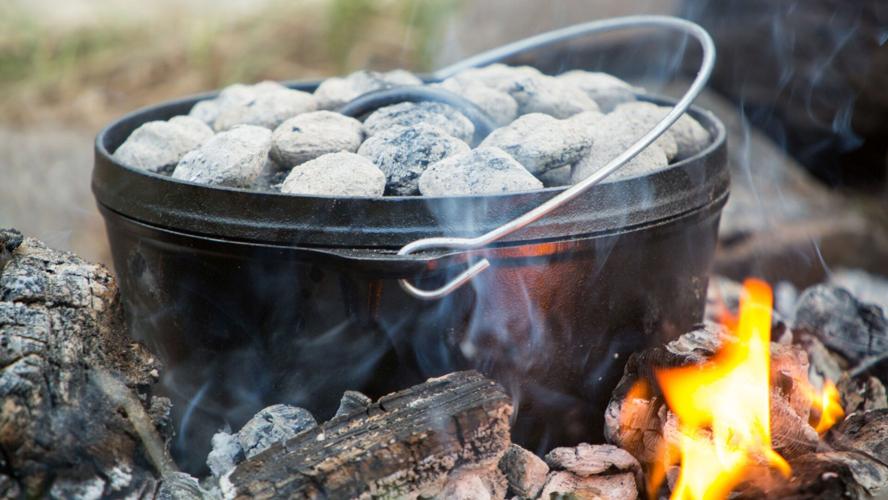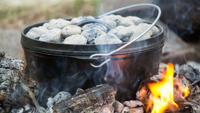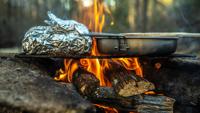(CNN) 鈥� No disrespect to s鈥檓ores and hot dogs, which have earned their spot at the top of the 鈥渇ood you eat around a campfire鈥� pyramid. But they鈥檙e not the only foods (sweet or savory) you could cook and enjoy in the great outdoors 鈥� or in your backyard.
I鈥檓 a cook who doesn鈥檛 have central air conditioning in her home, so I鈥檝e frequently relied on my gas grill for when the weather gets hot and steamy. As the years have gone by, however, I鈥檝e turned to my backyard firepit as another option.
There鈥檚 just something fun and a little adventurous about cooking over a live fire. It can also feel a bit intimidating if you鈥檙e used to the controlled world of induction burners and the quick turn of a knob, but it鈥檚 easy to get the hang of campfire cooking once you鈥檝e done it a few times.
This summer, why not take it upon yourself to cook a few simple meals over a fire? Consider this challenge your earned-in-advance summer cooking badge.
Start with a few key items
As with an indoor kitchen, you鈥檒l need a few crucial tools to make your outdoor cooking expeditions a success. Don鈥檛 worry, they鈥檙e nothing fancy 鈥� you likely have most of them in your arsenal already.
鈥� Cast-iron skillet and/or Dutch oven: Do not use coated nonstick or ceramic pans since they鈥檙e not designed to withstand the high heat of a fire. Cast iron is naturally nonstick and can handle the heat evenly.
鈥� Fireproof barbecue gloves: Upgrade your everyday kitchen mitts and get an insulated pair of gloves that offer better protection.
鈥� Long-handled metal tongs and a spatula: Again, be mindful of using items that can withstand high heat. Inexpensive plastic spatulas will likely warp or soften when left near the heat of a fire and wood burns, so keep any utensils safely away from flames.
鈥� Heavy duty aluminum foil: You鈥檒l need this when making foil packet meals.
鈥� Camp grill grate: A basic metal grate with foldable legs allows you to place your skillet or ingredients above 鈥� not directly in 鈥� the fire.
Get ready to cook safely
If it鈥檚 your first time cooking over live fire, you鈥檒l probably be a bit nervous.
鈥淭he biggest safety risks are getting burned by not wearing gloves or by a grease flare-up,鈥� said Dani Meyer, founder of blog and author of 鈥�.鈥� Keep your gloves on and protect your arms with long sleeves when reaching over the fire.
Even if you鈥檙e not cooking anything over a campfire or firepit, always keep a bucket of water or a hose within arms鈥� reach to douse any flames quickly and stop a fire from spreading out of control.
If you鈥檙e planning on cooking greasy or oily foods, be aware that sparks from the fire can ignite the oil and start a grease fire. Because water makes a grease fire spread, it shouldn鈥檛 be used in this instance. Keep a tight-fitting lid on hand to smother any flames in a skillet and use dirt or sand to extinguish any grease fires if necessary.
Start simple with skillet meals or foil packets
Think of a hot fire as your outdoor stovetop 鈥� if you鈥檇 cook it over a stove burner with a skillet or pan, you can also make it over a fire with a grill grate.
Once the fire has been burning for at least 10 minutes and a bed of shimmering coals is building under your logs, place a grill grate over the fire as your cooking surface. You can by safely placing your hand in the approximate spot where the grate would go. If you can hold it there for about five seconds before you need to pull it away, you鈥檙e at the sweet spot for cooking.
You can preheat your cast-iron skillet on the grate, cook food directly on the grate (great for steaks, chops or kebabs) or cook using foil packets.
are one of the easiest meals a campfire cooking newbie can make: They are simple to prep in advance and store in the fridge or in a cooler until you鈥檙e ready to cook, and can incorporate almost any combination of vegetables, proteins and seasonings you can dream up (such as !).
For skillet cooking, you can experiment with some of your usual one-pan meals transferred to the outdoors. Grilled skillet or are always comfort food favorites, or make and serve with tortillas freshly warmed over the fire. Try or loaded for a group snack.
Go to the next level and cook in the coals
If a hot fire is equivalent to an outdoor stovetop, cooking in the coals and embers once the fire has died down is equivalent to cooking in the oven. Unlike the strong but variable heat of flames, coals have a more steady heat with which to work. However, 鈥渃oal cooking is more advanced and can be a bit finicky,鈥� Meyer said.
This is because it takes a while for a fire to burn down to the point where you鈥檒l have enough coals to cook in, and it takes some trial and error until you can determine how long it will take for your meal to cook in a bed of coals.
Foil packet meals can be placed directly in the coals or embers 鈥� be sure to turn them occasionally for even cooking.
For larger meals, it鈥檚 time to pull out the cast-iron Dutch oven, an incredibly versatile piece of outdoor cookware. Just as you would with its indoor counterpart, you can cook slow-simmered stews such as or , or use it for baked casserole dishes such as or .
You can even use a Dutch oven to 鈥渂ake鈥� carby snacks such as or . Meyer recommends lining the Dutch oven with parchment paper or foil before adding sticky or messy ingredients, 鈥渂ecause cleaning a Dutch oven out when you have burned something is awful,鈥� she noted.
One note: High-sided stainless steel firepits, such as Solo Stoves, aren鈥檛 the best option for cooking in coals. You鈥檒l need a lower-to-the-ground fire ring or firepit if you鈥檙e not cooking in a campfire.
is a food writer, artist and editor of the website .
The-CNN-Wire
鈩� & 漏 2023 Cable News Network, Inc., a Warner Bros. Discovery Company. All rights reserved.






















